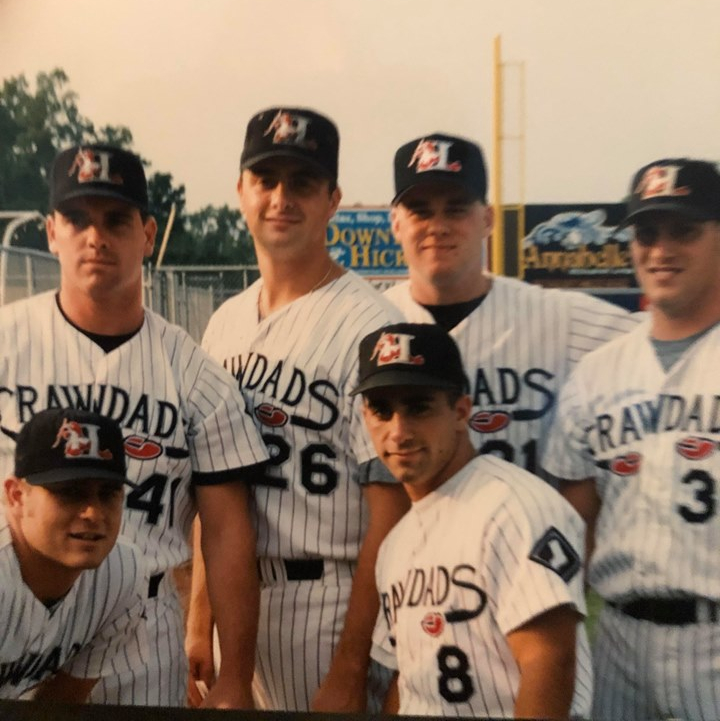
(The following is what I hope will be a series of articles about each of the 27 seasons of Hickory baseball. As I crank out more entries, the layout may get tweaked, but the idea was to give a sense of some of the names that came to L.P. Frans Stadium, as well as their stories. For this article about the 1993, I reached out to as many players and personnel through social media. My thanks to Ted Rich, Chris Gay, Dre Levias, Chris Mader, JuJu Phillips, Bill Proctor, Bob Mumma and John Quirk for responding with their memories and, in some cases, their photos. Many thanks also to Ashley Salinas of the Hickory Crawdads for scrapbook photos, which will be a part of this story.)
As the Hickory Crawdads wait to play their 28th season at L.P. Frans Stadium, it is hard to imagine the area without minor league baseball. However, Catawba County was without a professional team for 30 years after the Newton-Conover Twins of the Class D Western Carolina League folded up shop after the 1962 season.
To break the drought of pro baseball, the wheels went into motion to bring a team back to Hickory. The city’s last minor league was a one-season return of the Hickory Rebels in 1960, also in the Western Carolina League. (The Rebels also played in 1939-1940, 1942 and 1945-54).
After six seasons at Sims Legion Park off I-85 in Gastonia, Don Beaver led a group that purchased the Gastonia Rangers from then-Charlotte Hornets owner George Shinn. On land donated by the Winkler Family, L.P. Frans Stadium – named after Pepsi bottler Lee Polk Frans, who financed construction – took shape amid the surrounding forest to begin play in the South Atlantic League in 1993.
While games were played and future major leaguers came to town, the story of those early days were the people of Hickory, who embraced the idea of pro baseball playing in their town.
“I first remember the overwhelming support for the grassroots campaign of politicians and business leaders, who led the fundraising efforts for a new ballpark,” said JuJu Phillips, who was on the steering committee that helped to make the dream of professional baseball come true and later served as one of the team’s public address announcers. “The excitement of bringing back professional sports was over the moon. It was Hickory’s ‘Age of Innocence’ about pro sports and baseball, an idea that became reality in a few short years. It was a definite ‘can do’ spirit that existed back then.”
With the biennial change of minor league affiliations due, the Crawdads ditched the Texas Rangers as the parent club and brought on the Chicago White Sox, which had made shifts of their own. The White Sox dropped its short-season affiliate in Utica, N.Y. in favor of two class Low-A teams. South Bend (Ind.) and now Hickory.
The town welcome its first players:
With the area hungry for pro baseball, the reception of the players by the locals was overwhelming.
“The team was considered rock stars,” Phillips said. “Limousines brought them from the Charlotte Airport for a “Meet the Crawdads” event at Frans Stadium before the season opener.”
Chris Mader, who played third for the Crawdads in the inaugural season, said the players got caught up in the excitement of the fans for the new team. “The people were truly jazzed to have a professional sports team in Hickory and the city was on fire. No matter where we went, the people were so welcoming and wanted to ask questions, get autographs, and ensure the players enjoyed living there.”
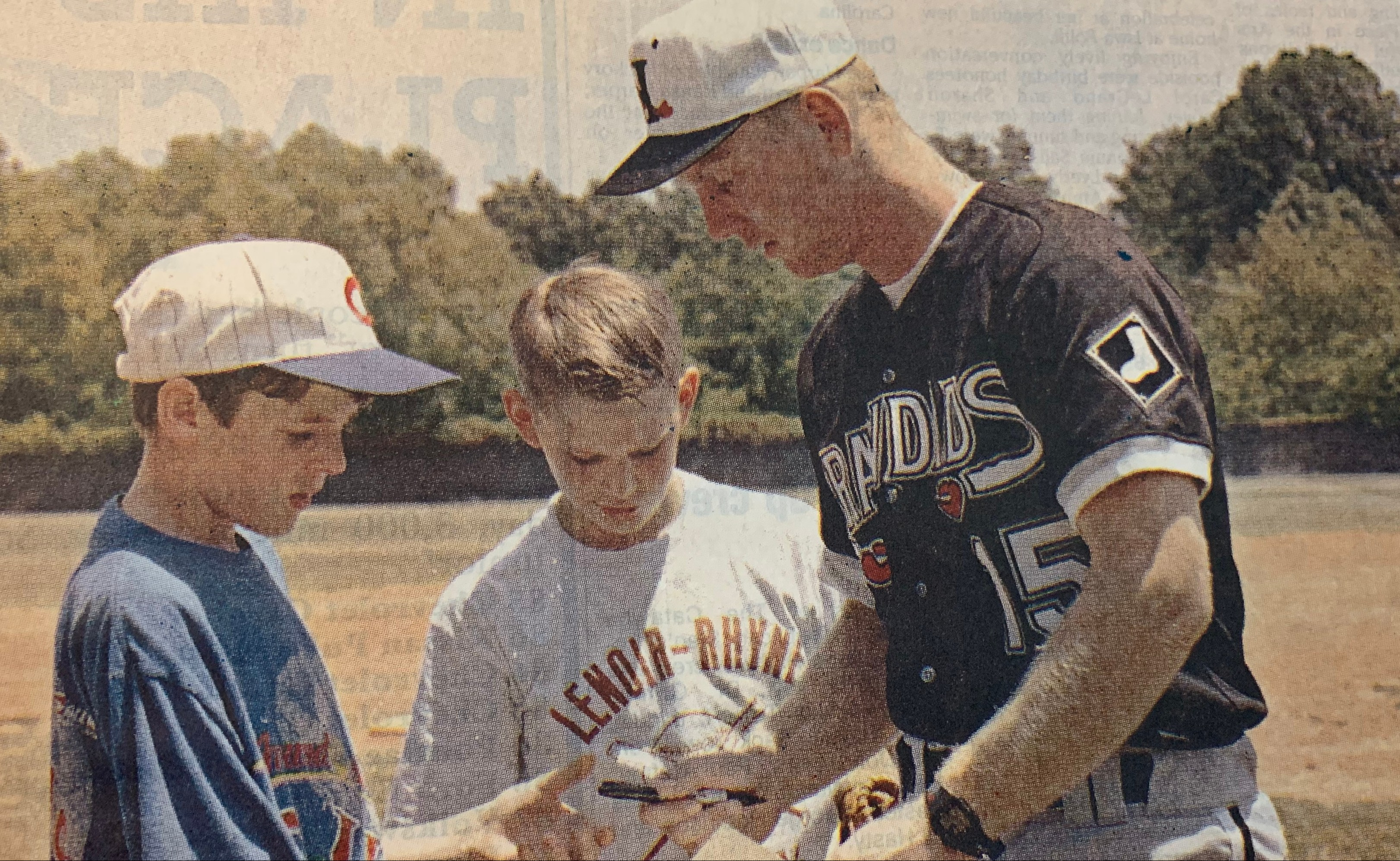
The excitement translated into box office success for the Crawdads, which drew 283,727 fans for the season, still a club record. However, the first year was not without its hiccups.
First-year growing pains:
A few weeks before the season began, the so-called “Storm of the Century” dumped nearly a foot of snow in Hickory on March 13. That put further pressure on construction workers to get the stadium ready for a mid-April opener.
When the time came to play ball, L.P. Frans was still being put together. From the unfinished canopy to unpaved parking lots, there was still work to be done. Most notably, the clubhouse was not finished.
“(My) favorite memory was on opening day,” recalled pitcher Chris Gay. “They still hadn’t finished the clubhouse because of a big snow off season. So, we were dressing in motor homes and had to hang our clothes on a piece of rope!”
Mader remembered the trailer-home clubhouses more vividly. “So, we only had access to a trailer (no showers, no training room, weight room, etc.) And not showering after an eight-hour day in a baseball uniform made that trailer nice and ripe after games!”
The parking lot took a while to get paved, as well. Pitcher Bill Proctor, who came to the Crawdads for the second half of the season after the White Sox took him in the 1993 draft, said the scene took him back to his home in Oregon.
“Every night,” Proctor recalled, “I just remember all the cars coming and going and all the dust that would be flying everywhere. It reminded me of being home on the farm by how dusty it was.”
Along with the stadium complex, the new field still had its share of issues. Outfield Dre Levias remembered how it affected him on a particular play.
“The outfield grass was laid in patches; therefore, the baseball would bounce from left to right making it hard to field ground balls. One game, a hard ground ball was hit to center field. I bent down to field it and when I looked up, the ball was nowhere in sight. It had went straight through my legs, not touching any of my glove – all the way to the outfield wall, Man, that was the longest run of my life going to get that baseball.”
As a team goes through its first season of doing things, lessons are learned. Such as it was on a fireworks night. Phillips had this memory:
“The night the hillside caught on fire during fireworks, which the team seemed to have about once a homestand, or every Friday and Saturday nights. Anyway, it was before the Hickory Fire Department came and watered down everything. We finished our interviews, walked back to the press conference to witness a major fire, that was near the gas reservoir also on the hillside.”
The Games Begin:
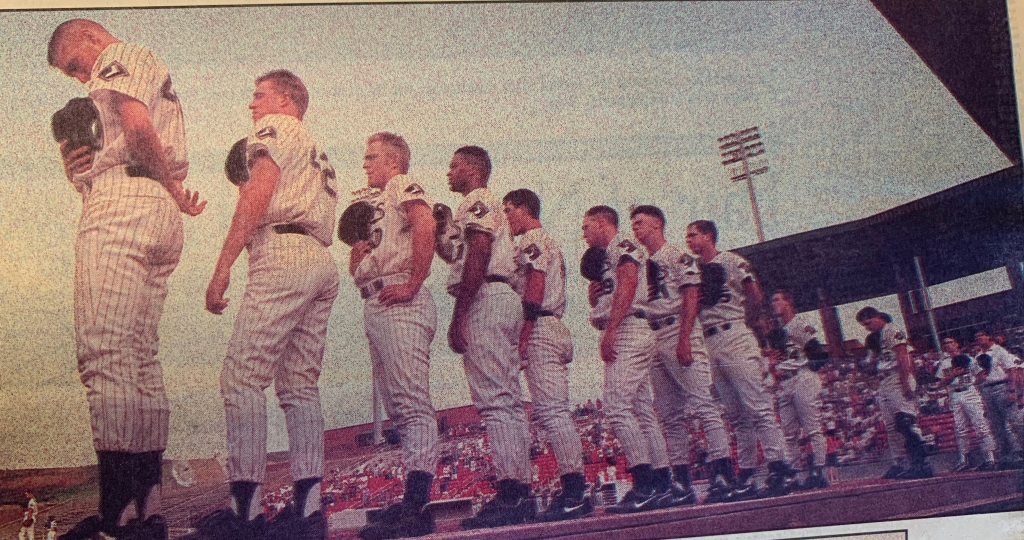
The team opened on the road and went 2-6 (the Crawdads as a franchise did not get above .500 until the 2014 season) before playing their first home game against Fayetteville (NC) on April 16. David Elsbernd threw the first pitch, Eddie Pearson had the first hit and scored the first run, and 6-foot-5, 240 lb. Juan Thomas blasted the first home run for Hickory. The Crawdads went on to win the first game 5-3 in front of 5,026 fans that squeezed into the ballpark.
The intensity of the fan base lasted throughout the season, and according to the Phillips, it was a crowd that stayed into every pitch.
“Fans often waited several hours to get tickets,” said Phillips of the buzz during the game, which lasted until the last out. “(They) cheered at everything. Groundouts to short, mostly though after good plays, and even the walk-up music that we played on cassette tapes. We usually tried to have something that had a person’s name in the song, even the opposition. It was a different time, more innocent. Except I used to have fans bring me beer especially on Thirsty Thursday.”
First baseman Ted Rich said the energy was felt on the field, as well.
“When (catcher) Bob Mumma would step into the batter’s box,” recounted Rich. “The announcer would say ‘Bob Moooooooooma’. And the whole crowd would yell ‘Mooooooooma’. It was fantastic.
Rich added, “The atmosphere was electric every night. Packed stadium (4500 fans I think), great announcers and between innings entertainment, and of course the Crawdad speeding around the field on the ATV. We were not a good baseball team, but the fans packed the stadium and supported us all season.”

Hickory went 52-88 in 1993, however, the love affair the fans had with the team did not wane.
“Since I didn’t get to Hickory until after the 1993 draft (14th round), I missed the first couple months there,” Proctor remembered. “The fans were crazy for baseball and I just remember the atmosphere was so energized.”
Ben Boulware, who was a seventh-round pick out of Cal Poly in 1993, was more direct. “You train your entire life,” said Boulware, “and to come to Hickory with a first-year stadium and crowd going nuts, (it) was super special and something I will never forget.”
Promotions:
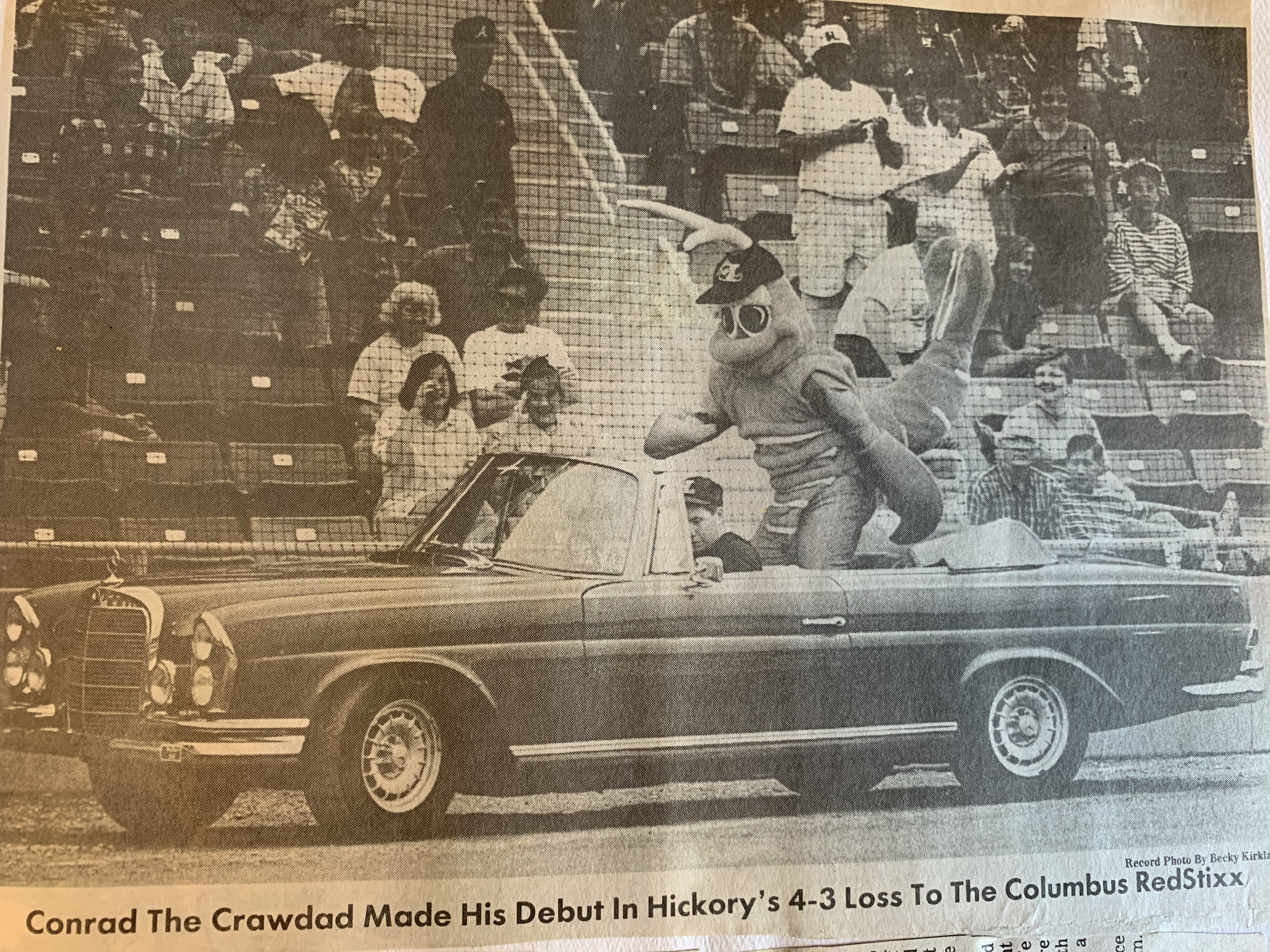
By all accounts, Chris Mader was the most popular player on the team that first season. A 53rd-round pick of the White Sox in 1991, he was the team’s only representative to the South Atlantic All-Star Game that season. He still has the club’s eighth highest on-base pct. in a season (.398), which was aided by 81 walks, the third most in a season.

The legend of Mader perhaps began on what would be an otherwise mundane night in April. The local Domino’s Pizza had a promotion that when the Crawdads scored ten or more runs, everyone in attendance would receive a small cheese pizza the next day.
The Crawdads had reached nine runs after seven innings with one more shot at pizza glory.
“As I recall,” Phillips said, “the chant went up for “Pizza, pizza, pizza” from the crowd of 3400.” Mader delivered with a two-run double that sent the fans into a frenzy – “it was like we had won the World Series,” said Mader – and the Domino’s franchise into a frenzy the next day to make good on the short-lived promotion.
Mader also had the honor of a ballpark item named after him.
“We had a lot of great promotions,” said Mader. “But I have to say, the day I found out they named a sandwich after me in the right field grille was something I will never forget! The ‘Toe- Mater’ sandwich.”
As teams often do, famous figures from sports are brought in for meet-and-greets with fans. One such guest had a special memory for Ted Rich.
“There was a night when Warren Spahn threw out the first pitch,” said Rich. “He was one of my Dad’s heroes, and he autographed a ball for me that night that my father still has today.”
Future Major League Players:
Seven Crawdads from the 1993 team went on to achieve major league status. Arguably, the most successful major leaguer to have played at Hickory was Magglio Ordonez. Six times an American League all-star, and the first former Crawdad to start in the Mid-Summer Classic (2007). Ordonez is the only former Hickory player to reach 2,000 hits and he finished his career with a .309/.369/.502 slash line.
“I had some great teammates,” Mader recounted. “But the guy with the most tools was Magglio Ordonez. He was a 5-tool guy (batting, hitting for power, fielding, throwing & running). He was rough around the edges and Hickory, but I knew he would make it all the way to the big leagues.”
However, as a skinny 19-year-old in his first full season, the Venezuelan hit .216 in 84 games with a .330 slugging pct.
“Magglio Ordonez was on that team,” said Phillips. “But, who could have seen a 165-pound skinny outfielder who hit under .200 that first year would ever make it to the big leagues as a slugger.”
Two other players that had major league impacts were Frank Menechino and Greg Norton. Menechino parlayed a 45th-round pick out of Alabama into a seven-year career with Oakland and Toronto. He is currently the hitting coach for the White Sox.

“At the time,” remembered Proctor, “I always thought that Frankie Menechino was the best player on that team. He showed up a couple weeks after me. The way he played the game and went about his business impressed me. The first time I shook his hand and he had this vice grip of a handshake; I knew the kid was tough as nails. He was a great teammate, leader and was fun to have in club house.”
Norton was the White Sox’s second-round pick out of Oklahoma. He joined the Crawdads just after his selection by Chicago. Although he hit just .244 that summer with Hickory, he made an impression on several of his Crawdads teammates.
“Greg could play multiple positions and had a sweet left-handed swing,” said Ted Rich of Norton, who spent 13 seasons in the majors, often as a key bench player.
Pitcher John Quirk, another 1993 White Sox draftee added to the Crawdads in the second half was enamored of both Menechino and Norton. Selected in the 23rd round, Quirk immediately saw those two were above anything he had seen at Westchester CC in New York.
“We had Magglio,” said Quirk. “But he wasn’t developed yet. Frankie just played with an edge and no fear and Norton was just as smooth as they come. Great bat and a great glove. You’ve got to understand, I played at a small JUCO and these guys played at Alabama and Oklahoma. So, I was in awe in the beginning.”
The Crawdads had two catchers go on to the majors. Catcher Chris Tremie was the first former Crawdad to make it to the majors, when the White Sox called him up on July 1, 1995. He spent brief tenures with four different teams before giving it up after the 2004 season.
Nerio Rodriguez had 13 errors and 12 passed balls in 72 games behind the plate for Hickory. The Baltimore Orioles turned him into a pitcher in 1995 at high-A ball and Rodriguez shot up the latter to the majors the next year. While he did not catch on long term in the big leagues, he became a force in the Mexican League, where he was named that circuits pitcher of the year twice.

Pitchers Mike Bertotti and Tom Fordham each had brief bit-parts with the White Sox in the mid-90s.
Magglio Ordonez and the Waffle House:
Mader was Ordonez’ roommate on the road, and, as such, Crawdads’ manager Fred Kendall gave him the assignment of watching over the future major league star.
“Our manager wanted to make sure I took care of him,” said Mader. “So, I would make sure that he was working out, getting to meetings on time, etc. When we would go on the road, one of my favorite stops was always the Waffle House, because we do not have those restaurants back in the Northeast.
“So, I would take Magglio with me, and as he was learning English, he would just read the sign and would pronounce it “waffly-hoo.” Keep in mind, we were not making a bunch of money, so the price point at the Waffle House is also quite attractive to us at that time! But the way he would pronounce it would just crack me up. So, whenever we would go on the road, our favorite restaurant was always the “waffly-hoo”.
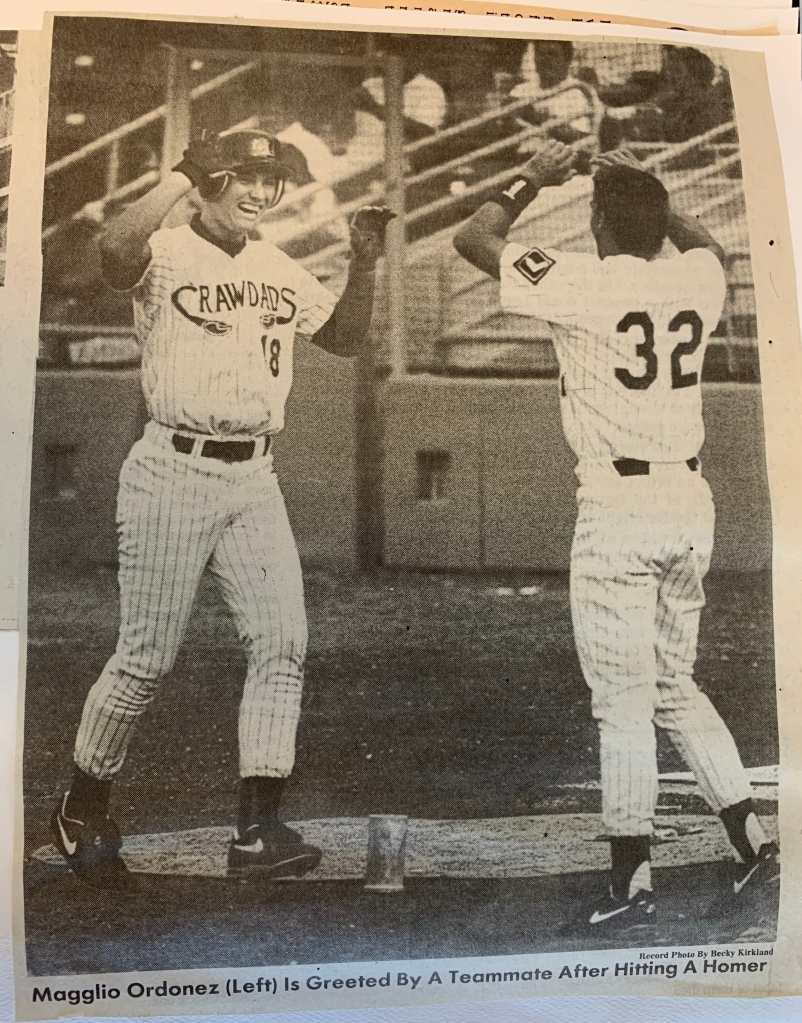
A tough season:
Overall, the 1993 Crawdads were not a particularly good team, as the offense often sputtered. As a group, the offense set several lows that still stand. The Crawdads hit just .224, nearly 20 points lower than the next worst team in the South Atlantic League. The 1993 team still holds marks for the fewest hits (1028 in 140 games), doubles (166), homers (48), total bases and slugging (.307). On the mound, they had just one shutout, 22 saves and walked 566 hitters, all club worsts.
As the losses mounted, the frustration of manager Fred Kendall increased, according to Phillips, who often covered post-game pressers outside the team’s double wide.

“The fiery skipper often times would blow off steam after the losses mounted,” Phillips shared. “He was very creative with his use of the F-bomb as a noun, verb, adjective, and adverb. He reminded me of a cross between Jim Leyland, and Jim Mora.”
Memorable Games:
Along with “Pizza Night” and the L.P. Frans opener, the 1993 season had a few memorable moments. Perhaps the biggest of them all came on May 15th when Wayne Lindemann pitched the only nine-inning, complete-game, no-hitter in team history in a game at Albany, Ga.
Bill Proctor remembered his initiation into low-A in a game he pitched against Greensboro, then a Yankees affiliate.
“At the time,” said Proctor, “I had no clue how good this player would be or who he would become. All the Crawdads players were hyping this guy up before I faced him. Derek Jeter was the first professional player I pitched to in a game. I remember that moment like yesterday. Derek Jeter, Nick Delvecchio and Matt Luke, in that order in Greensboro.
For Quirk, a diehard Yankees fan, it was his second start against a hated rival.
“My favorite moment on the field was beating Capital City (Columbia, SC) in my second start 2-1. I lost to Fayetteville in my first start, so I was super excited that I won. It was great because they were a Met affiliate and I was always a Met hater. They had Ron Washington as their manager and Brian Daubauch (Major Leaguer) and Tim Timmons (MLB Umpire) was supposed do the plate, but he got sick.”
Away from the Park:
According to several players, Yesterday’s was the favorite spot to hang out after a game. However, it nearly got one player in trouble.
“My favorite off-the-field memory,” said Quirk, “Was when Fred (Kendall) said if we got caught out after curfew we were going home. We went to, I believe, Yesterday’s and Fred walked in and I crawled out the door. “Fred seemed mean, but he was really good to me my whole career.”
However, the biggest off-the-field pastime was provided by a local, Ron Goans, referred to affectionately as “Captain Ron.”
“Myself and a few players met a man we called Capt. Ron,” said Bob Mumma. “He would take us out on the lake after some games and on our off days. I loved the lake at night. Did some fishing and some drinking and just relaxed to get away from baseball for a while.”
Quirk stated that Ron and his wife Kathy were “very generous to all of us and treated us like family…I still keep contact with them. Beautiful people.”
Mader said that the Goans helped players fill in the inevitable gaps that came with making about $850 a month.
“Not only would he let us borrow necessary home goods like plates, silverware, etc.,” Mader said. “But he would occasionally take us out on fishing trips on his boat and those were some of the fondest memories that me and many of my teammates had while in Hickory. He also introduced us to “double cupping” on the boat. Which I soon learned was having two red solo cups, and mixing bourbon with Sun Drop, and switching the cups back-and-forth to mix the drink. Genius!”
1993 HICKORY CRAWDADS Win/Loss: 52-88 Attendance: 283,727
ROSTER (Post-Crawdads baseball career):
FIELD STAFF:
MANAGER: Fred Kendall: The native of Torrance, CA spent 12 seasons as a catcher in the major leagues, much of them with the San Diego Padres with whom he was on the original team in 1969. He played one season each with Cleveland and Boston before capping his career with a return to San Diego for the 1979 and 1980 seasons. His minor league managerial career started in 1992 at Utica (NY) before he moved up in the affiliation to Hickory for two years. Kendall had several tenures as a major league bullpen coach with Detroit, Colorado and Kansas City. He retired after the 2007 season.

PITCHING COACH: Curt Hasler: He has been in the White Sox system since playing with the rookie affiliate in the Gulf Coast League in 1987. Hasler became a coach when he joined the Crawdads for their first two seasons. His first major league tenure as a coach came in 2017, when the White Sox named him their bullpen coach. Hasler is now the team’s assistant pitching coach.
HITTING COACH: Mark Salas: He played eight seasons in the major leagues with six different clubs before leaving as an active player in 1991. Two seasons later, he joined the White Sox as a coach at Hickory and has remained with the organization since. Salas has been the team’s bullpen catcher since 2007.
PITCHERS:
Ricky Bennett: Spent one more season in the White Sox organization before he started a front office career as an area scout with the Detroit Tigers. Was Director of Player Development with the Houston Astros from 2005 to 2010. Has been a pro scout with the Pittsburgh Pirates since 2013.
Mike Bertotti: Spent just nine games with Hickory (11.61 Ks per 9 IP). Had a quick ascent with the White Sox and debuted with the team in July 1995. Was up and down with Chicago through 1997, then bounced around minor league baseball with Oakland, Seattle and the Yankees. Last pitched in 2002 with New Jersey of the Northern League (indy ball). Is currently a baseball instructor at Frozen Ropes in New York.
Mark Brincks: Pitched the 1994 season in the White Sox organization before his release. Had two seasons with Moose Jaw in the independent Prairie League.
Don Culberson: Was released by the White Sox in 1993. Pitched two seasons for the Cubs organization, making it to High-A Daytona before leaving the game.
David Elsbernd: Returned to make six more appearances for Hickory before his release.
Dave Fitzpatrick: Made six relief outings for Hickory in 1993, then pitched in ten games at Low-A South Bend in 1994 before his release.
Tom Fordham: Returned to make 17 starts for Hickory in 1994. He made it to Chicago in 1997 and had a short stay over two seasons with the big-league club. Played in the Milwaukee (2000-01) and Pittsburgh (2003) organizations before leaving the game.
Chris Gay: Was released by the White Sox in 1993. Last pitched for Rochester of the Northern League. Currently owns Cover All Bases baseball training center in Arlington, Tex.
Toby Lehman: Stayed in the White Sox chain one more season before spending two seasons in the Baltimore Orioles organization. Reached the AA level at Bowie in 1995.
Wayne Lindemann: The only player to throw a 9-inning no-hitter for the Crawdads. Was in the White Sox system through 1995, but did not advance past high-A.
Johnny Malaver: Released after nine games with Hickory in 1993.
Andy McCormack: Did not advance past Low-A with the White Sox through 1995 but enjoyed a stint at AA Akron-Canton with the Cleveland organization in 1996.
Doug McGraw: Had just five games (1 start) with Hickory before his release. Pitched in 1994 at Osceola (High-A/ Houston) before leaving baseball.
Mickey McKinion: Returned to Hickory in 1994 for 28 games before his release.
Jason Odgen: Spent one more season with the White Sox in 1994, making it to High-A before his release.
Richard Pratt: A 1993 draftee out of South Carolina, he returned to have one of the best seasons in Crawdads history the following year (11-6 in 29 games/ 23 starts, 2.02 ERA). Still holds the club record for lowest ERA by a qualifying pitcher (112 IP) in a season and is third in WHIP (1.01). Made it to AAA Calgary in 1998 before parting ways with the White Sox. Pitched more season at Bridgeport in the Atlantic League (indy) in 1999.
Bill Proctor: Played one more season in the White Sox chain in 1994 before his release.
John Quirk: Stayed in the White Sox system through 1996 but did not advance past high-A. Played independent ball in the Northern League at Bangor in 1997 and New Jersey in 1998. Later went on to coach college ball. Was the pitching coach at Fairleigh Dickinson in 2006 before a three-year stint as the head coach at Lehman College (NY) from 2007 to 2009.
Juan Soto: Released after three starts for Hickory.
Fred Starks: Released by the White Sox while at Hickory in 1993.

Robert Theodile: Drafted by Chicago in 1992, the right-hander made 41 starts (2nd in club history) for Hickory over three seasons. He eventually moved up to high-A to stay in 1996 and made it all the way to AAA Calgary in 1998 before he shifting to the Milwaukee Brewers chain in 1999. Theodile last pitched in 2001 for Saltillo in the Mexican League.
Brian Woods: Drafted by the White Sox in 1993, the Northeastern Conference pitcher of the year moved up to South Bend after ten starts. Woods stayed with the White Sox through 1998 and made it as far as AAA Nashville. He had a brief stint at AA New Haven (Colorado) before calling it a career.

Pitching Leaders
| Wins | Ricky Bennett | 8 | |||
| Losses | David Elsbernd | 9 | |||
| ERA | Mike Bertotti | 2.11 | |||
| Games Pitched | Ricky Bennett | 41 | |||
| Games Started | David Elsbernd | 19 | |||
| Complete Games | Wayne Lindemann, David Elsbernd 2 | ||||
| Shutouts | Wayne Lindemann | 1 | |||
| Saves | Toby Lehman | 7 | |||
| Innings Pitched | Ricky Bennett | 112 | |||
| Hits Allowed | Ricky Bennett | 112 | |||
| Runs Allowed | David Elsbernd | 74 | |||
| Earned Runs Allowed | David Elsbernd | 51 | |||
| Home Runs Allowed | Mickey McKinion | 12 | |||
| Hit Batters | Toby Lehman | 12 | |||
| Walks Allowed | Toby Lehman | 57 | |||
| Walks per 9 IP | Ricky Bennett | 1,85 | |||
| Strikeouts | Ricky Bennett | 98 | |||
| Ks per 9 IP | Mike Bertotti | 11.61 | |||
| Wild Pitches | Fred Starks | 10 | |||
| WHIP | Mike Bertotti | 1.19 | |||
CATCHERS:
Wayne Faircloth: Stayed in the White Sox chain through 1994 before his release.
Bob Mumma: Had parts of two seasons with the Crawdads and they moved up to South Bend before his release. He returned to his alma mater at Maryland-Baltimore County in 1996 to become an assistant. Mumma took over the program as the head coach in 2012 before resigning from the position after the 2019 season.
Nerio Rodriguez: After struggling at and behind the plate, the Baltimore Orioles took him on as a pitcher and it was with the Orioles that Rodriguez made his major league debut in 1996. He bounced to the Toronto Blue Jays, Cleveland Indians and St. Louis Cardinals through 2002 and last pitched for an affiliated team with the Pirates chain in 2006. It was with Monclova of the Mexican League that Rodriguez made his mark, with three all-star game selections. He was named the circuit’s pitcher of the year in 2007 and 2008. Rodriguez was a pitching coach for the Los Angeles Angels system in the Dominican Summer League until 2016.
Chris Tremie: The first Crawdads to get to the majors, Tremie had brief stints with the White Sox, Rangers, Pirates and Astros, with whom he wrapped up his career in 2005. Tremie moved into coaching the next year with the Cleveland Indians and stayed in the system through 2018, the last six seasons as the manager at AAA Columbus. He is now in his second year as the minor league field coordinator for Cincinnati.
Infielders:
Ben Boulware: Hit just .193 in 18 games for Hickory after the White Sox took his as the 7th round pick out of Clemson but returned the next year to win the South Atlantic League batting title (.332). Played his entire career in the White Sox chain, last in 1997 at High-A Winston-Salem. Currently the owner of Baum Bats.
Jason Evans: Played his entire career in the White Sox chain, making it to AAA in 1997 with Calgary. His final season was at AAA Nashville a year later. Currently works in Hickory as a mortgage broker.

Dan Fraraccio: Had a brief stint at AAA Nashville in 1995 but played mostly at high-A with the White Sox before his release in 1996. Bounced back to AAA to stay with the Tampa Bay Devil Rays and San Diego Padres chains before ending his career at Las Vegas in 2000.
Scot Hollrah: Released while with the Crawdads in 1993.
Chris Mader: Arguably the most popular player in the first season, Mader returned to the team for a second season before his release. The Cleveland Indians picked him up and he finished his baseball career in 1995 with high-A Kinston.
Frank Menechino: Drafted in the 45th round out of Alabama, he thrived during the season’s second half at Hickory, posting a .281/.403/.416 slash. Menechino was a key player for Oakland, as the Athletics went to the playoffs three times during his six seasons there. His major league career capped with Toronto in 2004-2005, but Menechino stayed in the game as a player through 2008 in the Italian League. He started his coaching career in 2009 with the New York Yankees system and got his first major league coaching job with Miami in 2014. He is currently the hitting coach for the White Sox.
Geovanny Miranda: The Panamanian had one more season with the White Sox, that including a turn at AAA Nashville before his release. Miranda coached for two seasons with the Toronto Blue Jays, including a South Atlantic league turn at Low-A Charleston (WV) in 2001.
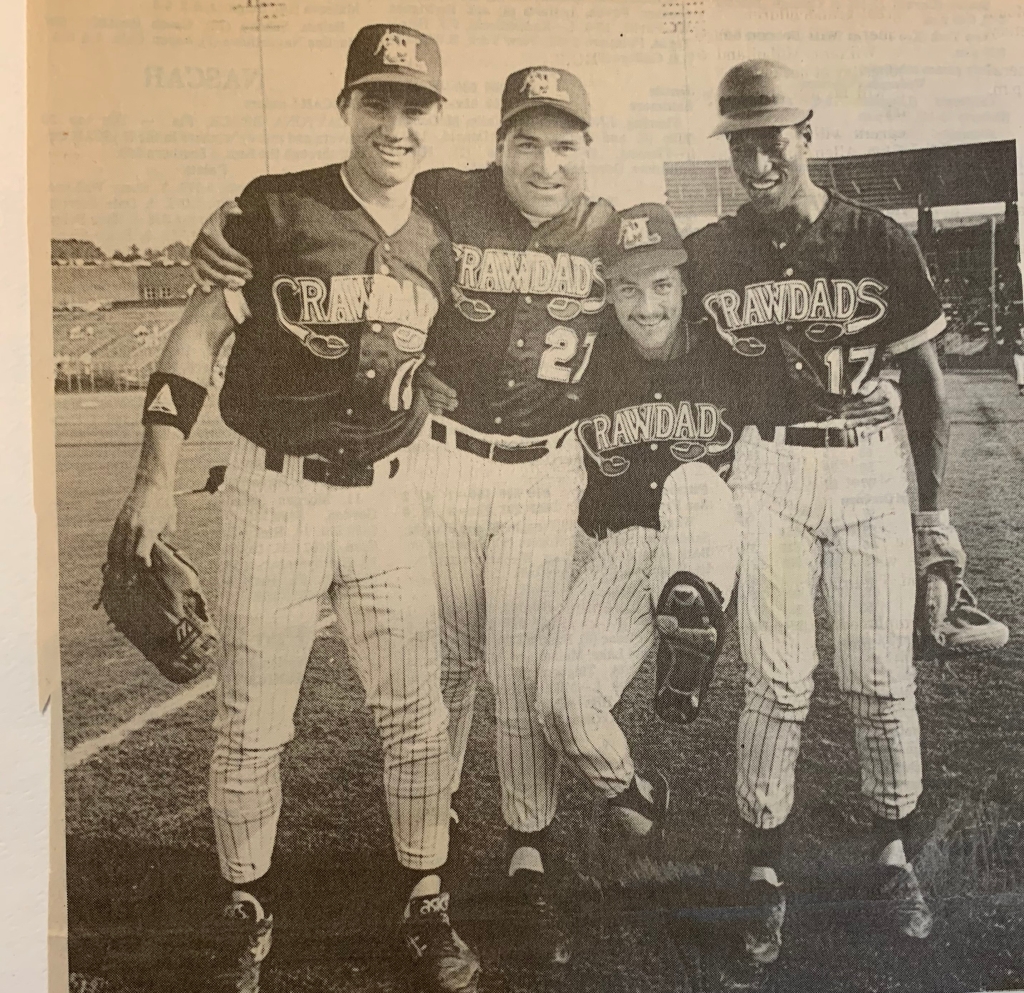
Greg Norton: The second-round pick of the White Sox played in 71 games for Hickory before a quick climb up the chain. His big-league debut came with the White Sox in August 1996. Norton spent 13 seasons in the majors with six team, the last coming in 2009 with Atlanta. A year later, Norton was the hitting coach at AAA New Orleans, then became the manager of the club for two seasons. After serving as the hitting coach at Auburn, Norton returned to coaching in pro ball as the minor league hitting coordinator for the Boston Red Sox, where he remains in his fifth season.
Eddie Pearson: The White Sox first-round pick in 1992 stayed in the chain through 1998 but could not get past AAA before he signed to play in Korea in 1999. From then, Pearson spent the remainder of his career bouncing between the Mexican League and independent ball, where he received several all-star nods. Pearson was the 2003 Northern League player of the year, while at St. Paul, but he was unable to receive another shot with an affiliated team. His last season came in 2006 with Kansas City in the Northern League.
Wil Polidor: He played just 15 games with Hickory and topped out at AA with the White Sox in 1998 before they cut him loose. Polidor got one more shot in the Philadelphia Phillies chain before they, too, released him in 1999. He went on to become a player agent and is now with the Octagon Agency, with which he has represented several players, including Felix Hernandez.
Mike Randle: He went 0-for-6 in three games with Hickory before his release.
Jimmy Reyes: The middle infielder lasted just one more season with the White Sox at South Bend and high-A Sarasota before his release.

Ted Rich: The University of Florida alum played in 16 games at Hickory before the White Sox let him go.
Juan Thomas: The slugging 1B stayed in the White Sox chain through 1997, but it was with the Seattle Mariners organization that Thomas reached his peak in 2001 at AAA Tacoma. Cincinnati also gave him a shot at the same level in 2003 before Thomas left affiliated ball for good. He bounced around several indy league teams before his career ended in the Golden League at Calgary. Thomas was a volunteer assistant coach with Augustana (SD) College from 2012 to 2015.
OUTFIELDERS:
Geronimo Aquino: Went 0-for-10 with 8 Ks in four games before the White Sox released him.
Marc Harris: Played in 79 games for Hickory but hit just .188 before he was released by the White Sox.
Dre Levias: Returned for the 1994 season before he bounced around the White Sox system at three levels in 1995-1996. Hit his ceiling at High-A Winston-Salem before his release.
Sandy McKinnon: Remained with the White Sox through 1998, reaching the AA level his final two seasons. The Arizona Diamondbacks picked him up for the 1999 season and his final games came with AA El Paso.
Magglio Ordonez: Named to the initial class of the Crawdads’ hall of fame in 2014. Played 15 seasons in the major leagues with Chicago White Sox and the Detroit Tigers. Hit a walk-off home run for Detroit to clinch the 2006 American League Championship Series and a World Series berth. Won the AL batting title in 2007 (.363). Had a 200-hit season in 2007. Posted seven seasons of 100+ RBI, four seasons of 100+ runs scored and four consecutive 30+ HR seasons (1999-2002). Won three Silver Slugger Awards. Named to the All-Star Game six time and became the first former Crawdad to start in the game in 2007. Was second in the AL MVP voting in 2007.
Scott Patton: Returned to the Crawdads in 1994 before the White Sox let him go. Went back home to college to play football at Saddleback College (CA) and then Nevada-Las Vegas. Was an NJCAA All-American in 1995.
Eric Richardson: Led the team with 42 steals in 1993, which is still the 10th highest total for a season in club history. Returned to Hickory for part of the 1994 before a bump-up to South Bend. He made it to high-A before his release. Richardson coached a couple of seasons (2004-05) in the Phillies system. He returned as a coach in the White Sox chain in 2018 at rookie affiliate Great Falls.

HITTING LEADERS:
| GAMES PLAYED | Chris Mader | 120 | |||
| BATTING AVG | Frank Menechino | .281 | |||
| AT BATS | Eric Richardson | 412 | |||
| RUNS | Chris Mader | 54 | |||
| HITS | Chris Mader | 107 | |||
| SINGLES | Eric Richardson | 83 | |||
| DOUBLES | Chris Mader | 25 | |||
| TRIPLES | Jimmy Reyes | 7 | |||
| HOME RUNS | Juan Thomas | 12 | |||
| RBIS | Chris Mader | 49 | |||
| TOTAL BASES | Chris Mader | 155 | |||
| WALKS | Chris Mader | 81 | |||
| INTENTIONAL WALKS | Jason Evans | 2 | |||
| STRIKEOUTS | Juan Thomas | 124 | |||
| STOLEN BASES | Eric Richardson | 42 | |||
| Caught Stolen | Eric Richardson | 15 | |||
| On Base PCT | Frank Menechino | .403 | |||
| Slugging Pct | Juan Thomas | .418 | |||
| Sacrifice Flies | Chris Mader, Greg Norton, Jimmy Reyes 4 | ||||
| Sacrifice Hits | Jimmy Reyes | 8 | |||
| Hit By Pitch | Juan Thomas | 7 | |||
